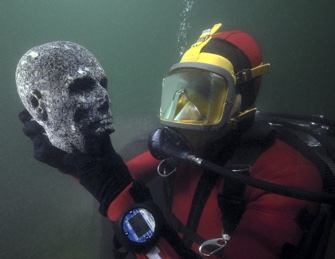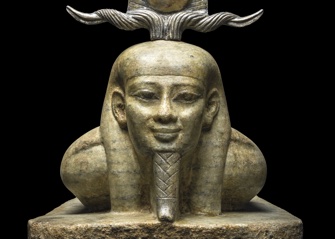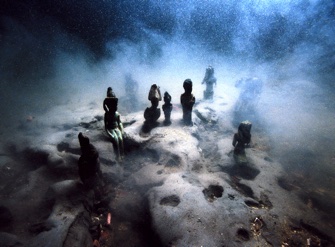Fishing for Artifacts in
Egypt’s Watery Underworld

The head of a priest from the Ptolemaic period, discovered in the eastern port of Alexandria. Photo: Christoph Gerigk © Franck Goddio/Hilti Foundation
Legend has it that the dismembered body of Osiris, a king of Ancient Egypt, was discarded in the River Nile after he was murdered by his brother Seth. Osiris was awakened from his watery grave by his sister/wife, the goddess

“The Awakening of Osiris.” Egyptian Museum, Cairo. Photo: Christoph Gerigk © Franck Goddio/Hilti Foundation
Isis, with whom the resurrected king, now the immortal god of the afterlife, created the child Horus, heir to Egypt. Echoing this fundamental myth of Egyptian civilization, the French archaeologist Franck Goddio has plunged into the underwater world of Egypt and given an afterlife to two lost towns and numerous artifacts, which provide the basis for the exhibition “Osiris, Sunken Mysteries of Egypt” at Paris’s Institut du Monde Arabe.
The explorations conducted by Goddio, a former financial advisor, have earned him a reputation as a pioneering underwater archaeologist. The 250 objects he and his team uncovered from the ancient cities of Thonis-Heracleion and Canopus are being shown to the public for the first time, along with artifacts loaned by museums in Alexandria and Cairo. Together, they provide insight into the fascinating story of Osiris and the ceremonies and cults dedicated to him.
Thonis-Heracleion and Canopus, located near Alexandria, were both submerged under the sea in the second or third century following natural disasters. Prior to Goddio’s excavations, which began in 2000, no trace of Thonis-Heracleion, supposedly the first piece of land Hercules set foot on in Egypt, had ever been found; the city remained a legend occasionally mentioned in ancient texts.
On entering the exhibition, visitors are instantly submerged in a world of sub-aquatic darkness with eerie music and lapping sounds.

Bronze statuettes from Thonis-Heracleion. 6th-2nd century B.C.E. Photo: Christoph Gerigk © Franck Goddio/Hilti Foundation
Videos of Goddio’s underwater excavations hold you transfixed while the ripples of low filtered lighting and wall projections enhance the supernatural ambiance.
This atmospheric setting provides an appropriate backdrop for the ancient masterpieces on show, impressive in both their colossal scale and minute details. The towering statue of the Nile god Hapi, who reigns over the annual flooding of the river, dominates the first room. The enormity of the pink granite figure dating from the Ptolemaic period fittingly represents the colossal architecture and monumental achievements of the Egyptian Empire.
A stunning Roman statue of the holy Apis bull, discovered in the underground galleries of the Serapeum in Alexandria, is similarly arresting. It was modeled on a real-life bull that had been raised in a temple in Memphis and then ritually buried as part of annual celebrations devoted to Osiris, emulating the entombment of the dead king as closely as possible.
A black granite effigy of a queen, most likely representing Cleopatra II or Cleopatra III and dating from around 305-30 B.C.E., was recovered from Thonis-Heracleion. Standing proud and erect, she is dressed as Isis, with the iconic “Isis knot” coiffure and classic dress. The figure is an example of Egyptian queens’ custom of emulating the beloved goddess. The queen’s noble silhouette is accentuated by the dramatic black backdrop and vivid spotlight centered on her figure.
Aside from such jaw-dropping sights, the exhibition offers an incredible wealth of information on the almost month-long celebrations of Osiris. The offerings made, the custom of re-enacting the myth each year, and the importance of these rituals in ensuring the Nile’s annual retreat to allow plant life to flourish are illuminated in minute detail. In places, however, the show is in danger of overwhelming visitors with specifications, facts and dates, and drowning their fascination with these mysterious colossi just as they were once drowned in the depths of the Nile. When the freshly resurrected pieces are allowed to speak for themselves, however, you cannot fail to be bowled over by the ingenuity and skill of ancient Egyptian civilization.
Institut du Monde Arabe: 1, rue des Fossés-Saint-Bernard, Place Mohammed, 75005 Paris. Open Tuesday-Thursday, 10am-7pm; Friday, 10am-9:30pm; Saturday-Sunday, 10am-8pm. Through Jan. 31, 2016. www.imarabe.org
Reader reaction: Click here to respond to this article (your response may be published on this page and is subject to editing).
Please support Paris Update by ordering books from Paris Update’s Amazon store at no extra cost. Click on your preferred Amazon location: U.K., France, U.S.
More reviews of Paris art shows.
© 2015 Paris Update
Favorite